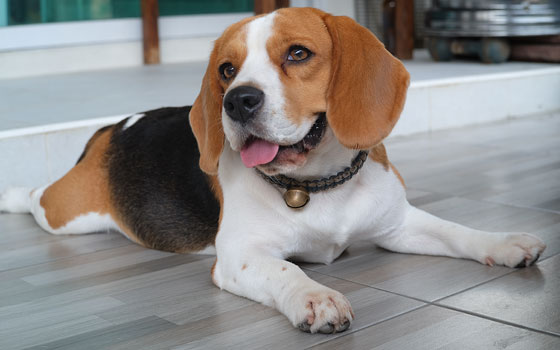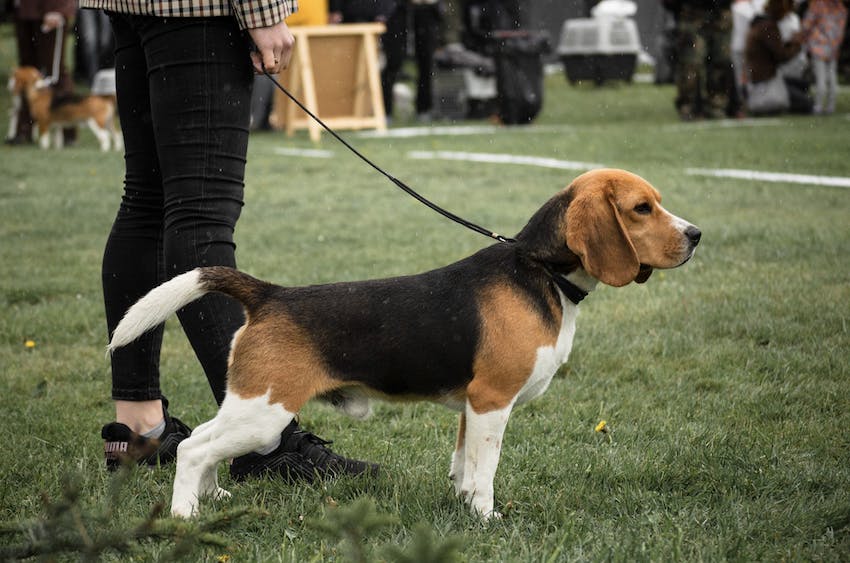Lifespan
10 to 15 years
Updated Sep 25, 2024
Lifespan
10 to 15 years
Weight
20 - 30 pounds
13 - 15 inches tall
Energy level
Mall Walker
Breed Group
Hound

Beagles always have a white-tipped tail. This way they could be seen through the thick
underbrush while on the hunt.
Beagles have a dense double coat, but since it’s short, it doesn’t require as much maintenance as other double-coated breeds. Tri-color Beagles are the most common (with coats of black, brown/tan, and white). Some Beagles are what’s called “particolored,” which is white and one other color — usually tan or brown for this breed. More rare Beagle colors include blue ticking, red ticking, and lemon.
Purebred Beagles always have a white-tipped tail, which was important for locating the dog when they were on a hunt and running through thick brush.
It’s best to start introducing positive experiences with bath time and other grooming when your Beagle is a puppy.
A Beagle is a breeze to groom, as a simple brushing once or twice a week helps to keep their coat looking dapper. Not only does regular brushing remove any loose dirt or debris, but it also helps spread natural oils through the coat and encourages new fur growth. Bathing should be done as needed, and Beagles are not the biggest fans of water (at least when it’s bathwater instead of pond water).
Best Brush for a Beagle: Bristle brush, Grooming mitt
A Beagle is a merry little hound who will always make their presence known by singing the song of their people. The world is all about one thing to a Beagle: following their nose... and their nose always finds its way to food. Beagles, like most hounds, have a one-track mind and are quite determined when they’re tracking a scent. Loving and playful, this breed is a hardy companion that is equally happy to run or nap.
Scent hounds have long been a part of human history, helping to find and track game during hunts. In England, where the Beagle breed was developed, there are mentions of packs of smaller hounds being used in hunts since before the Romans invaded in the 1st century. The hounds of the United Kingdom have certainly been around since antiquity.
The Beagle can trace its history to the hounds used throughout medieval times, such as the Talbot Hound, which was brought to England by William I in 1066. Through time, smaller hounds were favored for hunting small game such as rabbits and hare. Miniature versions of the Beagle were popular with a few royals. Edward II and Henry VII had packs of Glove Beagles in the 14th and 15th centuries, and Queen Elizabeth I kept Pocket Beagles that were small enough to fit in saddlebags before being released to hunt. Her Pocket Beagles measured only 8 to 9 inches tall.
The term beagle was used as a catch-all for all the smaller sized hounds. No one knows for sure how the word became linked to the dogs. One theory is it’s derived from the Gaelic word “beag,” which means little. The most entertaining theory is that it came from the French word “be’geule,” roughly translated to loudmouth. That would certainly fit with the sounds these hounds let loose when they catch the scent during the hunt.
Different sizes and types of hounds were refined over the centuries in England. It wasn’t until the 1800s that the modern-day Beagle was truly refined. The Southern Hound and the North Country Beagle were used in the 1700s to hunt hare and rabbit but became rarer as fox hunting gained in popularity, which required larger hounds. Luckily, small hounds became the perfect hunting dog for those that could either no longer ride in fox hunts or simply couldn’t afford to keep horses for fox hunting. They could be used for foot hunting, easily followed on foot. The North Country Beagle and the Southern Hound merged into one Beagle breed by the 1840s, and these beagles were the foundation of the modern-day breed.
With the introduction of dog shows in England in the late 1800s, the Beagle became more standardized, but the breed became more popular in the United States. First imported after the Civil War, Beagles quickly found their place as perfect dogs for rabbit hunting. The first Beagle was registered with the American Kennel Club in 1885.
Beagles are one of the most food-motivated breeds, but their nose rules above all. If you want to share your life with a Beagle, understanding the one-track mind of a hound dog is essential. Start training when your Beagle is young to build strong foundation behaviors, and focus on training a solid come-when-called cue. A great way to build a relationship with your Beagle is to take advantage of their natural talents and sign up for nose work or tracking classes. They make excellent scent detection dogs, and this will give them an appropriate outlet for their desire to sniff.
Because a Beagle is determined to follow a scent once they’ve locked onto it, it’s important for their safety that they are kept on a leash or in a securely fenced area when off-leash. Otherwise, they will wander off on an adventure of their own making.

Beagles are generally very friendly dogs that love to be the center of attention. Proper proactive exposure to new sights, sounds, people, dogs, and other animals as a young puppy is essential for their socialization skills.
This breed can make an excellent family dog since it’s small but sturdy. Socialization as a puppy, proper introductions, and handling them with respect will go a long way in building good relationships with kids. Young children and dogs should always be supervised, and it’s helpful for a dog to have their own “safe space” where they can go when they need some quiet time.
Beagles were kept in large packs throughout their history, and they are known to enjoy the company of other dogs in the home. Their higher prey drive (the propensity to chase running animals) can make living with smaller pets or cats a bit more challenging. With socialization during puppyhood and continued training and management as an adult, a Beagle can do well living with other pets.
While Beagles don’t have an overwhelming need for constant physical activity, they do need to get at least 30 minutes a day of exercise. The breed is prone to obesity (it seriously is all about food for Beagles), so make sure they’re working off any extra calories with playtime in the yard or long walks around the neighborhood.
Mental enrichment is important for this intelligent and fun-loving breed. You can work their brains by teaching new tricks, attending obedience classes, joining a dog sport, and providing dog puzzles and interactive toys. These activities are a wonderful outlet for their seemingly endless puppy energy and prevent boredom — which often leads to unwanted behaviors like destructive chewing or barking.
A Beagle’s nose is an amazing thing! Working their sniffer uses a lot of brainpower, making sniffing a powerful tool for mental enrichment. Provide your Beagle with lots of sniffing opportunities on walks or hikes, or play a fun nose work game indoors on a rainy day. Signing up for a tracking class will put a Beagle’s natural nosy talents to work and build your bond.
Due to their love of companionship, breed history as a pack dog, and social nature, Beagles need positive exposure to alone time from puppyhood, to prevent or minimize any separation anxiety issues as they get older. It’s much easier to prevent than to treat once it’s started. Many Beagle owners get a second Beagle so they can keep each other company. This can work to prevent or help with separation anxiety, but sometimes you might end up with two anxious Beagles instead. Make alone time a positive and relaxing experience for your Beagle.
Any time you leave your Beagle alone, pull out a frozen stuffed Kong or other yummy treat toys. When you return (even if only after thirty seconds), put it away until next time. This will help your Beagle learn that when you’re gone, awesome stuff happens and they’ll make a positive association with your absence.
Beagles do well in many different activities:
Beagles have long been a part of human pop culture, from doggy actors to memorable characters, to the pets of celebrities.